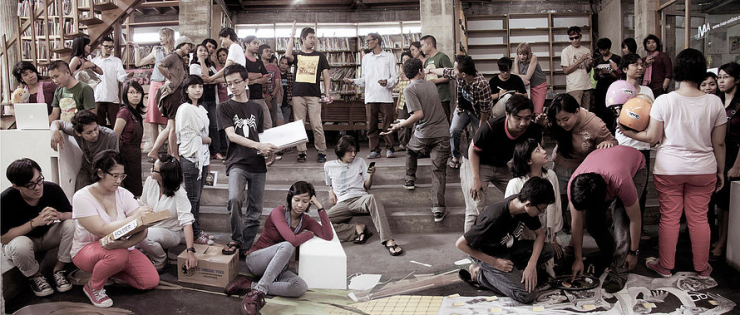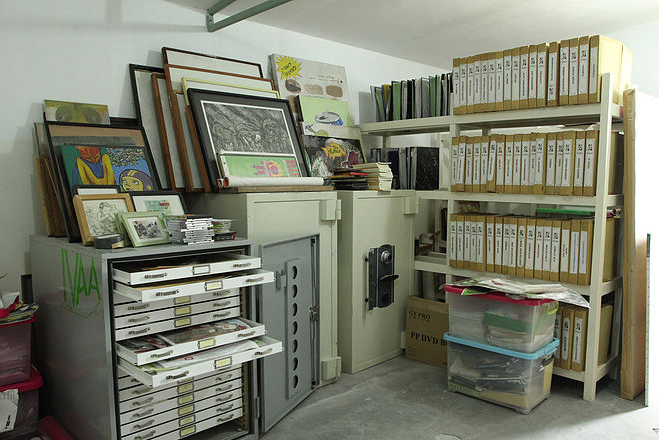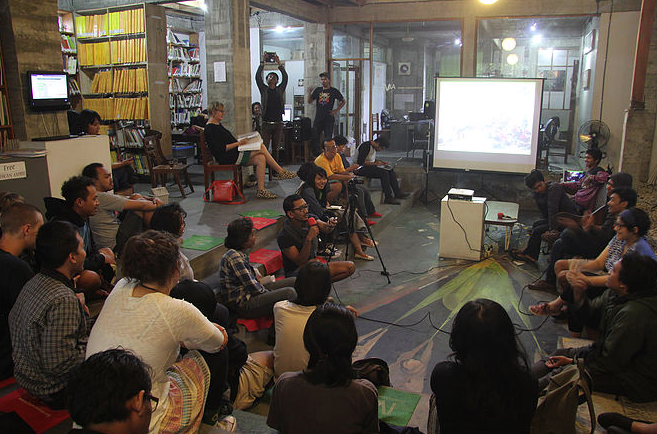The Indonesian Visual Art Archive (IVAA) was founded in Yogyakarta, April 2007. IVAA is a non-profit organization evolving from Cemeti Art Foundation (1995-2007) following a new direction as a centre for documentation and art archive provision as well as library and research facilitator.
IVAA collects photographs, audio visual records and printed documents documenting art practices dating from pre-independence until today. The collection is accessible from Rumah IVAA library as well as through IVAA Digital Archive http://archive.ivaa-online.org/. IVAA acts a hub hosting interactions among artists, curators, academics and people working in the field of visual art.
INCCA-AP interviews Farah Wardani, the Director of IVAA about the archive's great work in documenting Indonesian visual arts. Farah Wardani is an art historian, curator and writer, living and working in Yogyakarta, Indonesia.
Q: Tell us about the Indonesian Visual Art Archive (IVAA) and the Digital Archive. How was it started and what is IVAA’s vision?
A: IVAA’s digital archive began from our first attempt to re-register every document that was produced as well as gathered by Cemeti Art Foundation since it was founded. We were facing shelves of vertical folders containing bits and pieces from art shows/exhibitions, photos of art works with their information at the back, correspondence, transcripts, newspaper clipping, and more. They were not massive but surely consumed a lot of space in the rented small house where we used to operate. We wanted to propose a new design for the services that comprise a circulation library and regular coverage on local art events. Our idea was to have a comprehensive list of things that can reflect the dynamics of Indonesian contemporary art. The list should be able to index arrays of information such as name of the artists/art workers, art space/venue, titles of exhibited works, titles of writings, etc. In order to achieve that, we designed a system to enable electronic storage of the digital objects as well as a relational database schema. The whole process of designing, testing and finally publishing took about 3 years while we also try to expand the scope of topics to an earlier phase of visual art practice in Indonesia. With that in mind I think we envision research practices in Indonesian art scene can go beyond attempts to validate the value of artistic products but rather to affirm the practice of research itself, which in return will develop a stance towards a certain restlessness in trying to fixate a merely few 'formalized' version of Indonesian art history.
Q: According to an interview with Jakarta Post, you mentioned that IVAA’s total collection stands at 16 million items, consisting of photographs, audio visual records, art events, research books, artist portfolios and videos collected from all over the world. How can public access these collections? Is copyright an issue in regards to public access to these archive materials and how do you deal with it?
A: Everything mentioned above are available for viewing on site. The digital archive website and library catalogue act as preview of what items are available for immediate access if say, web users find it adequate to use only the web resolution images and PDFs or to listen to audio and watch video streams. Recently we have been receiving more requests via email that involves frequent correspondence and peer-to-peer file sharing. These days it is quite hard to tell which digital object is the most sensitive when considering its circulation via internet. We are taking precaution in the simplest form with letters of agreement, publishing only low resolution documents on the website and keeping track on the use of high resolution ones when they are requested. However as far as we’re concerned it is a pity if copyright issues prevail in our field of work, since generally any kind of documents describing activities, coverage, reports on Indonesian art are valuable resource for an ongoing process of understanding history itself.
Q: Other than archiving and collecting the above crucial documents, what other activities and projects does IVAA do?
A: In 2011 we curated our collection based on four major themes, Body and Gender, Environmental, Creative Industry and Diversity. All four were published as a compilation of visual archive known also as The Data Catalogue. In 2013 two books were published following a two-year pilot project among 5 other cultural archiving organization in Indonesia. The pilot took form as a network for knowledge sharing on digitalization and database where at the end of the project a grant was distributed to fund 11 proposals on archive utilization. Grantees who received funding for their proposals had worked with materials that are made available by the cultural archive network to create another creative product/event such as film, music, essay, workshop/forum, archive showcase, etc. Aside from producing publications we always try to maintain our connection with individuals and groups on collaborative projects as well as opening our space for ad-hoc forums.
Q: How do you foresee the future of IVAA and its role in the art and academic scene in Indonesia as well internationally?
A: We hope that IVAA can continue and develop as a research center that works together with art and academic scene in Indonesia and abroad, not only promoting Indonesian art and culture, but to build more engagement with the society As IVAA work progresses and the archiving activities develop with the cultural archiving network program and the new growing art public evolves, IVAA then has been moving on and expanding its role towards a broader field of arts, which also significantly impacts the range of our stakeholder, users and network in the arts. We regard this as an important and valuable progress and delightfully anticipate how the role can be further developed in the future. Taking the online and digital platform as its ground of archiving work, IVAA has also been very aware of the significance of Information and Communication Technology in contributing to its line of work. The latest developments of Media and ICT have proven to provide new means of communications, and new perspectives in developing, transform and reusing the practice and discourses of art and culture in the rapidly growing and highly mobile contemporary societies. As IVAA’s vision covers not only the development of visual art but also how the art scene in general can contribute to knowledge distribution, freedom of expression and social activism, the development of media and ICT has become one of the main contributing factor in our work, and will likely to continue to be that way into the future. In the context of the contemporary society, documentation and archiving (including the works of exploration and education that comes out of it) on the practice and discourses of art and culture fills in an important role, i.e. to develop them further in the vision of cultural and social investments of knowledge production for the future, and to balance the scenes which is currently still dominated by romanticism, elitism and fundamentalism. Nevertheless, media and technology have also often been considered as one of the factors that encourage mainstreaming, censorship and the dumbing-down of the art discourse in the society threatened by increasing fundamentalism. We are aware of this issue and remain to be up-to-date as well as continue to evaluate how media and ICT performs in the society today and tomorrow. We also hope to further build and develop network and involving them into our work in several collaborations. The network involves various dimensions of the society that expands not only limited to the art circles, but also scholars from various disciplines, librarians, IT and digital media experts and communities, creative industry practitioners, government agencies and social-cultural activists. The vision that we keep adhering to is to create an open access of knowledge with art as the medium of freedom of expression in the development of the society in this globalized, open-source information era, using the archive and resources in creative ways through digital platforms and community engagement methods and projects.
Q: What is IVAA’s current biggest obstacles and are there any particular assistance it requires?
A: Being an independent non-profit foundation it is easier to say that our biggest obstacle is about the lack of funding to maintain our sustainability. But I would like to say that our biggest obstacle, somehow, remains to be the lack of public awareness in the importance of art and cultural development in the Indonesian society – that is also due to the lack of concern by the State/government in creating a more condusive infrastructure for this field. The arts scene has always been run by independent initiatives like us and we find our own ways to build our own network and infrastructure organically – which put the art scene in the margins. Many of well-intentioned and great initiatives that actually play important roles are not being regarded as priorities. We hope that the situation will change, with support by networks like INCCA-AP to further bring out more initiatives in the arts like what we are doing now at IVAA to the surface.
Q: How can one join IVAA and provide support?
A: We encourage people to be a Kawan IVAA (Friends of IVAA), which enables people to receive updates on latest addition to the library or documentation, forums taking place at our community space - Rumah IVAA, etc. To register, visit http://ivaa-online.org and subscribe to the mailing list. Since 2008 our members are registered for a lifetime service where they can access high resolution files that have been uploaded via http://archive.ivaa-online.org as well as taking home two titles of most printed materials (books, magazines, etc.) via the library. Support in any kind is beneficial for the sustainability of our services, be it interests in having an internship in the library or documentation division, contribution in the forms of documents sharing, updates on upcoming art events, collaboration opportunities, access to personal archives and financial supports.
Q: What are your hopes for the INCCA-AP network? How would you like to see it develop?
A: As mentioned above, I do believe that INCCA-AP can play a very important role in bridging together initiatives in the Asia-Pacific that can collaborate together in building a more open access of knowledge in art history and conservation of this region – as well as maintaining and enhancing the importance of arts development in this contemporary society. I do hope to learn more from INCCA-AP, maybe through a series of training and networking programs in maximizing the use of technology as well as open-source platforms that can help developing our work.
First posted on incca-ap.org 2015 by Selina Halim


